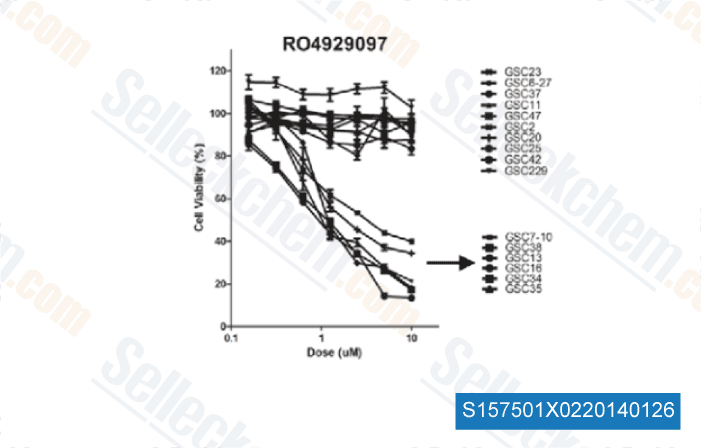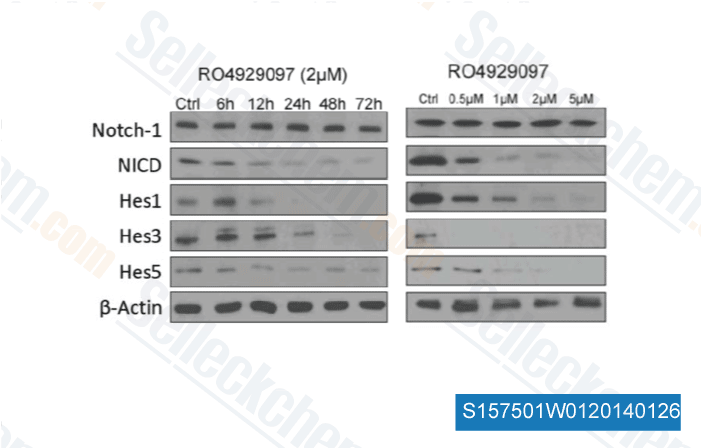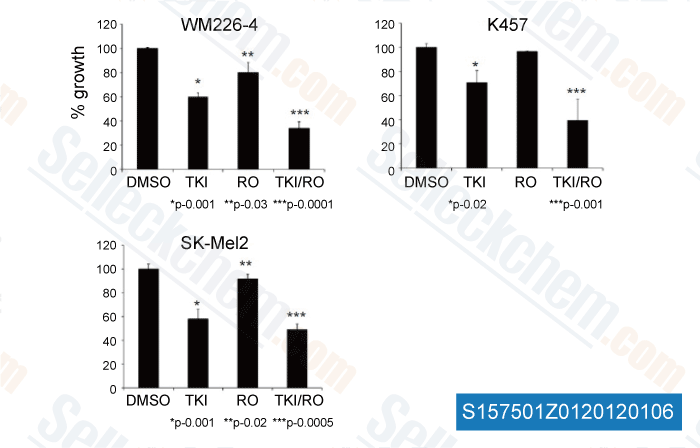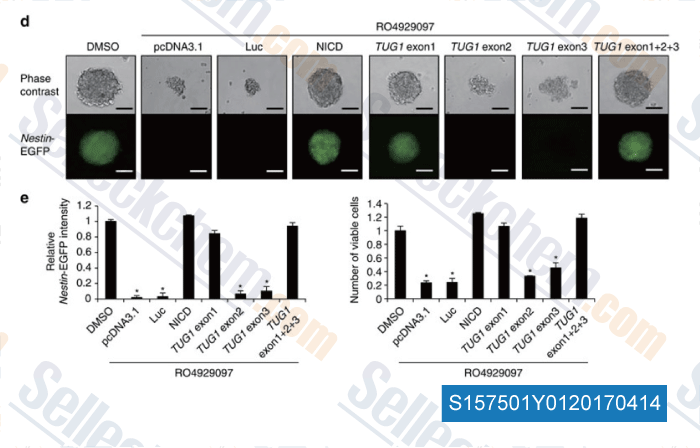|
Toll Free: (877) 796-6397 -- USA and Canada only -- |
Fax: +1-832-582-8590 Orders: +1-832-582-8158 |
Tech Support: +1-832-582-8158 Ext:3 Please provide your Order Number in the email. |
Technical Data
| Formula | C22H20F5N3O3 |
||||||||||
| Molecular Weight | 469.4 | CAS No. | 847925-91-1 | ||||||||
| Solubility (25°C)* | In vitro | DMSO | 93 mg/mL (198.12 mM) | ||||||||
| Ethanol | 93 mg/mL (198.12 mM) | ||||||||||
| Water | Insoluble | ||||||||||
| In vivo (Add solvents to the product individually and in order) |
|
||||||||||
|
* <1 mg/ml means slightly soluble or insoluble. * Please note that Selleck tests the solubility of all compounds in-house, and the actual solubility may differ slightly from published values. This is normal and is due to slight batch-to-batch variations. * Room temperature shipping (Stability testing shows this product can be shipped without any cooling measures.) |
|||||||||||
Preparing Stock Solutions
Biological Activity
| Description | RO4929097 (RG-4733) is a γ secretase inhibitor with IC50 of 4 nM in a cell-free assay, inhibiting cellular processing of Aβ40 and Notch with EC50 of 14 nM and 5 nM, respectively. Phase 2. | ||||||
|---|---|---|---|---|---|---|---|
| Targets |
|
||||||
| In vitro | RO4929097 decreases the amount of Aβ peptides secreted into the culture medium in HEK293 cells with EC50 of 14 nM. RO4929097 strongly inhibits Notch processing with EC50 of 5 nM in the Notch cell-based reporter assay. The potency of RO4929097 in cell-free and cellular assays is in the low nanomolar range with >100-fold selectivity observed with respect to 75 other proteins of various types including receptors, ion channels, and enzymes (CEREP panel). After 5 days of treatment, RO4929097 reduces the production of ICN in the human NSCLC A549 cells inducing a flattened and less transformed tumor cell phenotype in tissue culture. [1] RO4929097 blocks Notch processing in human non-small cell lung carcinoma cells and decreases expression of the Notch transcriptional target gene Hes1. Treatment with RO4929097 reveals a two- to threefold decrease in the expression of direct Notch target genes, Hes1, Hey1, and Heyl in SUM149 and a 3.5- to eightfold decrease in expression in SUM190 cells. RO4929097 modestly inhibits the growth of SUM149 cells in a dose-dependent manner. At a concentration of 1 μM of RO4929097, growth inhibition is 20 % for SUM149 and 10 % for SUM190 cells, relative to vehicle-treated controls. RO4929097 decreases the production of inflammatory cytokines by T-cells. Furthermore, with RO4929097 treatment, there is a shift in favor of TH2 over TH1 cytokines. In addition, T-cell activation induced IL-6 production would be increased with RO4929097. [2] Upon RO4929097 treatment, the selected melanoma cell lines reveals downregulation of NOTCH downstream effector HES1. A decrease in the amount of melanospheres formed upon RO4929097 treatment in primary melanoma cell lines is detected. [3] | ||||||
| In vivo | Oral injection of 3 to 60 mg/kg RO4929097 once daily or twice daily to nude mice bearing A549 NSCLC xenografts for either 7, 14, or 21 days of a 21-day schedule results in significant tumor growth inhibition compared with vehicle-treated animals. The tumor growth inhibition values ranges from 66% to 91%. When mice are treated with 60 mg/kg RO4929097 twice daily with the 7+/14- schedule, treatment initially arouses regression of established A549 tumors. At the end of the 21-day cycle (day 47), tumor growth prevention is still 91% compared with vehicle control mice. Inhibition of tumor growth remains prolonged and sustained up to 34 days post-treatment (day 67). On day 67, these mice are retreated with the same dose of RO4929097 for a second cycle (7 days) until day 74. Importantly, the antitumor effects are sustained after dosing is completed. [1] RO4929097 leads to reduced expression of genes associated with angiogenesis in A549 xenograft model. In contrast, the RO4929097-resistant H460a xenograft displays little change in expression of these genes, underscoring the in vivo anti-angiogenesis mechanism of action of RO4929097.[2] For IL6 and IL8 overexpressing tumors, RO4929097 no longer impacts angiogenesis or the infiltration of tumor associated fibroblasts. [4] |
Protocol (from reference)
| Kinase Assay:[5] |
|
|---|---|
| Cell Assay:[3] |
|
| Animal Study:[1] |
|
References
Customer Product Validation

-
Data from [Stem Cells, 2014, 32(1), 301-12]

-
Data from [Stem Cells, 2014, 32(1), 301-12]

-
, 2012, Dr. Barbara Bedogni of Case Western Reserve University

-
Data from [Data independently produced by , , Nat Commun, 2016, 7:13616]
Selleck's RO4929097 has been cited by 128 publications
| Role of the Notch signaling pathway in porcine oocyte maturation [ Cell Commun Signal, 2025, 23(1):1] | PubMed: 39748238 |
| Expression of genes involved in thyroid hormone action in human induced pluripotent stem cells during differentiation to insulin-producing cells: Effects of iopanoic acid on differentiation [ Mol Cell Endocrinol, 2025, 599:112490] | PubMed: 39921130 |
| Targeting endothelial PDGFR-β facilitates angiogenesis-associated bone formation through the PAK1/NICD axis [ J Cell Physiol, 2024, 10.1002/jcp.31291] | PubMed: 38721633 |
| Xenogenic Engraftment of Human-Induced Pluripotent Stem Cell-Derived Pancreatic Islet Cells in an Immunosuppressive Diabetic Göttingen Mini-Pig Model [ Cell Transplant, 2024, 33:9636897241288932] | PubMed: 39401129 |
| Novel Anti-B-cell Maturation Antigen Alpha-Amanitin Antibody-drug Conjugate HDP-101 Shows Superior Activity to Belantamab Mafodotin and Enhanced Efficacy in Deletion 17p Myeloma Models [ Res Sq, 2024, rs.3.rs-3843028] | PubMed: 38260385 |
| MYL3 protects chondrocytes from senescence by inhibiting clathrin-mediated endocytosis and activating of Notch signaling [ Nat Commun, 2023, 14(1):6190] | PubMed: 37794006 |
| MYL3 protects chondrocytes from senescence by inhibiting clathrin-mediated endocytosis and activating of Notch signaling [ Nat Commun, 2023, 14(1):6190] | PubMed: 37794006 |
| Simultaneous Inhibition of Ceramide Hydrolysis and Glycosylation Synergizes to Corrupt Mitochondrial Respiration and Signal Caspase Driven Cell Death in Drug-Resistant Acute Myeloid Leukemia [ Cancers (Basel), 2023, 15(6)1883] | PubMed: 36980769 |
| Elucidation of HHEX in pancreatic endoderm differentiation using a human iPSC differentiation model [ Sci Rep, 2023, 13(1):8659] | PubMed: 37248264 |
| Low-dose metformin targets the lysosomal AMPK pathway through PEN2 [ Nature, 2022, 603(7899):159-165] | PubMed: 35197629 |
RETURN POLICY
Selleck Chemical’s Unconditional Return Policy ensures a smooth online shopping experience for our customers. If you are in any way unsatisfied with your purchase, you may return any item(s) within 7 days of receiving it. In the event of product quality issues, either protocol related or product related problems, you may return any item(s) within 365 days from the original purchase date. Please follow the instructions below when returning products.
SHIPPING AND STORAGE
Selleck products are transported at room temperature. If you receive the product at room temperature, please rest assured, the Selleck Quality Inspection Department has conducted experiments to verify that the normal temperature placement of one month will not affect the biological activity of powder products. After collecting, please store the product according to the requirements described in the datasheet. Most Selleck products are stable under the recommended conditions.
NOT FOR HUMAN, VETERINARY DIAGNOSTIC OR THERAPEUTIC USE.
